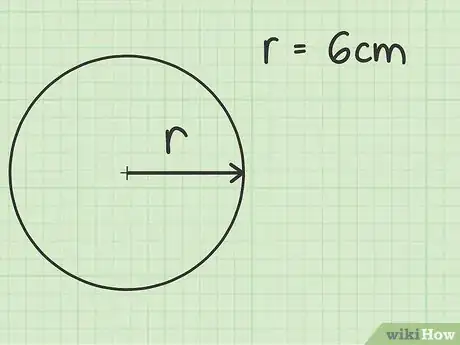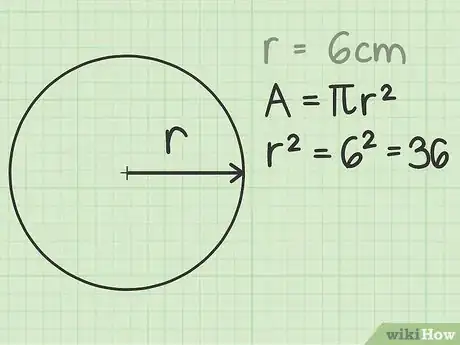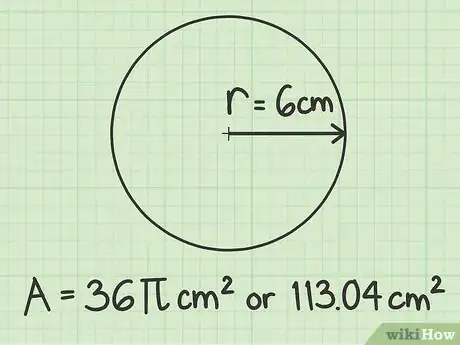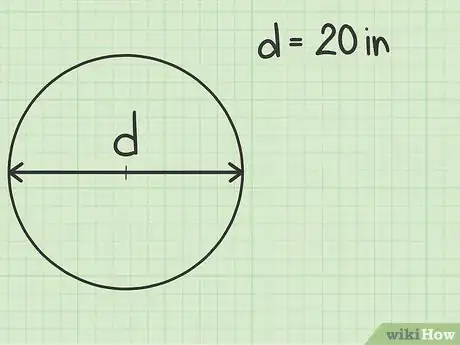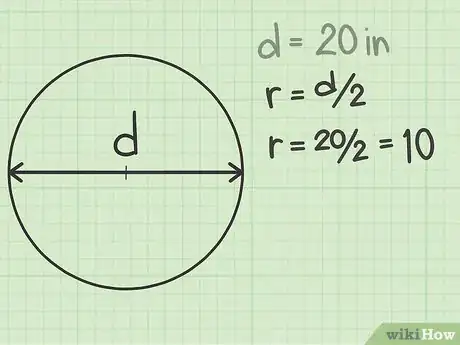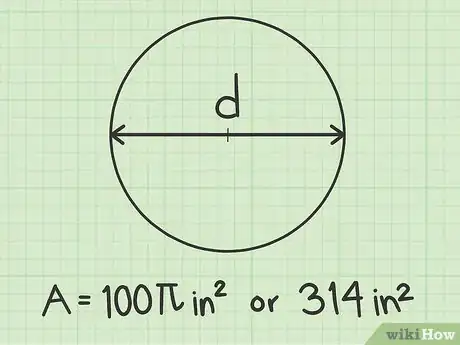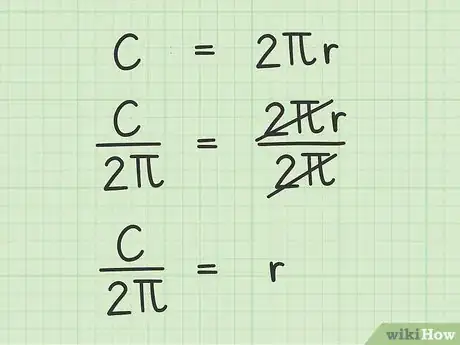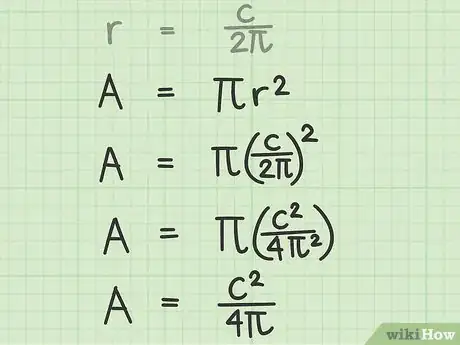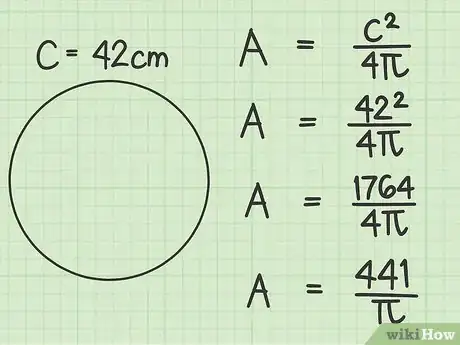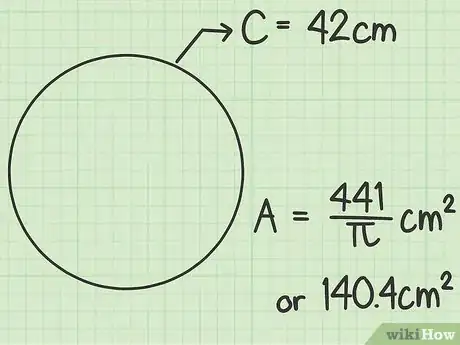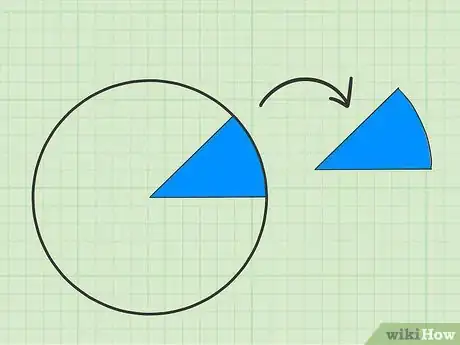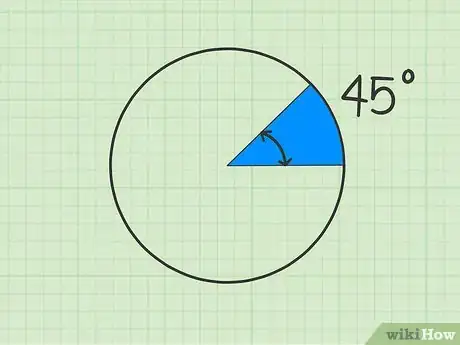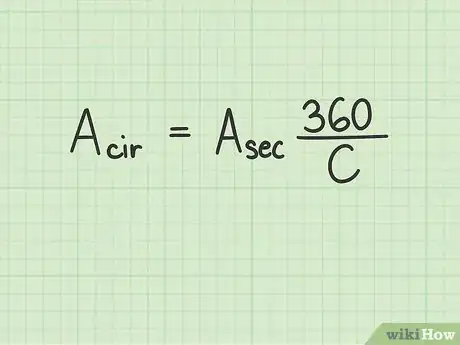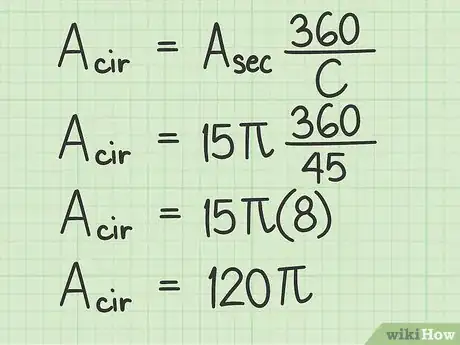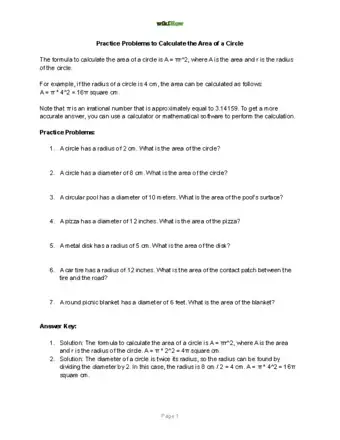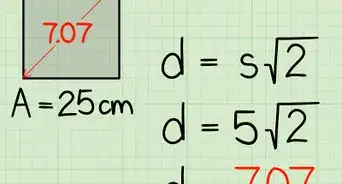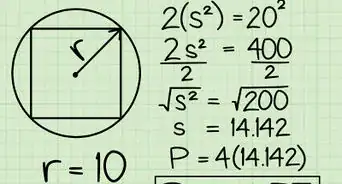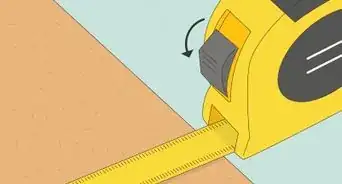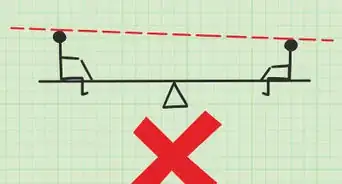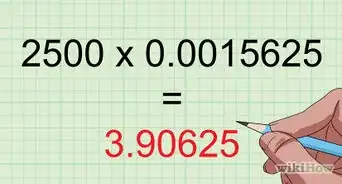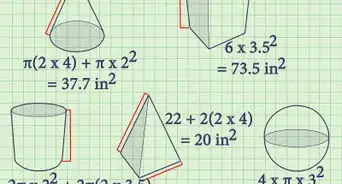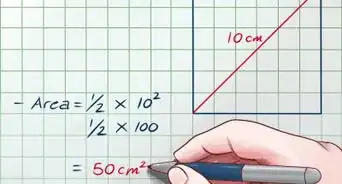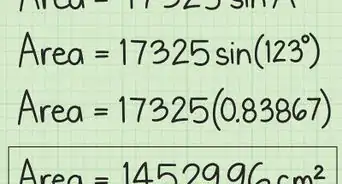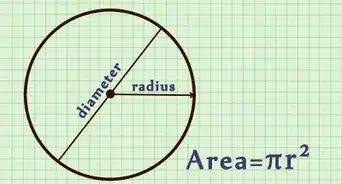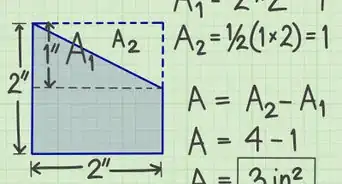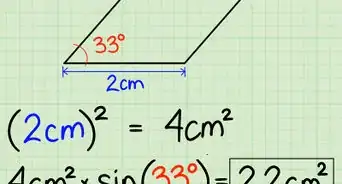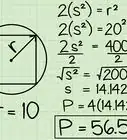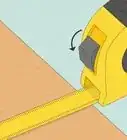This article was co-authored by Grace Imson, MA. Grace Imson is a math teacher with over 40 years of teaching experience. Grace is currently a math instructor at the City College of San Francisco and was previously in the Math Department at Saint Louis University. She has taught math at the elementary, middle, high school, and college levels. She has an MA in Education, specializing in Administration and Supervision from Saint Louis University.
This article has been viewed 5,766,225 times.
Need to know how to find the area of a circle? This is a common geometry problem and figuring out the answer is pretty easy. In most cases, you can use the simple formula . If you don't know the radius, don't worry! We'll help you solve for the area no matter what info you're given, thanks to some of our other formulas. Read on to learn how to calculate the area of a circle using the radius, diameter, circumference, or even a sector of a circle.
Steps
Using Radius to Find Area
-
1Identify the radius of a circle. The radius is the length from the center of a circle to the edge of the circle. You can measure this in any direction and the radius will be the same. The radius is also one half of the diameter of a circle. The diameter is the line segment that passes through the center and connects opposite sides of the circle.[1]
- The radius will generally be provided to you. It can be difficult to measure to the exact center of a circle, unless the center is already marked for you on a circle drawn on paper.
- For this example, assume that you are told that the radius of a given circle is 6 cm.
-
2Square the radius. The formula to find the area of a circle is , where the variable represents the radius. This variable is squared.[2]
- Do not get confused and square the entire equation.
- For the sample circle with radius, , then .
Advertisement -
3Multiply by pi. Pi, written symbolically with the Greek letter , is a mathematical constant that represents the ratio between the circumference and the diameter of the circle.[3] As a decimal approximation, is approximately 3.14. The true decimal value continues on infinitely. For an exact statement of the area of a circle, you will usually report your answer using the symbol itself.[4]
- For the given example with a radius of 6 cm, the area is calculated as:
- or
- For the given example with a radius of 6 cm, the area is calculated as:
-
4Report your result. Remember that a calculation of area is going to be reported in “square” units. If the radius was measured in centimeters, the area will be in square centimeters. If the radius was measured in feet, the area will be in square feet. You should also know whether to report your result using the symbol or the numerical approximation. If you do not know, then report both.[5]
- For the sample circle with a radius of 6 cm, the area will be either 36 cm2 or 113.04 cm2.
Calculating Area from the Diameter
-
1Measure or record the diameter. Some problems or situations will not provide you with the radius. Instead, you may be given the diameter of a circle. If the diameter is drawn into your diagram, you can measure it with a ruler. Alternatively, you may just be told the value of the diameter.
- Assume for this example that the diameter of your circle is 20 inches.
-
2Divide the diameter in half. Remember that the diameter is equal to double the radius. Therefore, whatever value you are given for the diameter, cut it in half and you will have the radius.
- Therefore, the sample circle with a diameter of 20 inches will have a radius of 20/2, or 10 inches.
-
3Use the original formula for area. After converting the diameter to the radius, you are ready to use the formula to calculate the area of the circle. Insert the value for the radius and perform the remaining calculations as follows:
-
4Report the value of the area. Recall that your area is to be reported in square units. In this example, the diameter was measured in inches, so the radius is in inches. Therefore, the area will be reported in square inches. For this sample, the area will be sq. in.
- You can also provide the numerical approximation by multiplying by 3.14 instead of . This will give a result of (100)(3.14) = 314 sq. in.
EXPERT TIPGrace Imson is a math teacher with over 40 years of teaching experience. Grace is currently a math instructor at the City College of San Francisco and was previously in the Math Department at Saint Louis University. She has taught math at the elementary, middle, high school, and college levels. She has an MA in Education, specializing in Administration and Supervision from Saint Louis University.Math Instructor, City College of San Francisco
 Grace Imson, MA
Grace Imson, MA
Math Instructor, City College of San FranciscoThe most common error when using diameter is forgetting to square the denominator. If you don't divide the diameter by 2 to find the radius, you can still find the area of the circle. However, you need to change the formula so that you square the 'd' otherwise your answer will be wrong.
Using Circumference to Calculate Area
-
1Learn the revised formula. If you know the circumference of a circle, you can use a revision of the formula for the area of a circle. This revised formula uses circumference directly, without the radius, to find area. This new formula is:
-
2Measure or record the circumference. In some real world situations, you may not be able to measure the diameter or radius accurately. If the diameter is not drawn for you or the center is not identified, it can be difficult to approximate the center of a circle. For some physical circles - a pizza pan or a frying pan, for example - you may be able to use a tape measure and measure the circumference more accurately than you can measure the diameter.[6]
- For this example, assume that you have been told or have measured that the circumference of a circle (or circular object) is 42 cm.
-
3Use the relationship between circumference and radius to revise the formula. The circumference of a circle is equal to pi times the diameter. This can be written as . Then, recall that the diameter is equal to twice the radius, or . You can combine these two equalities to create the following relationship: . Rearrange this to isolate the variable by itself, as follows:[7]
- ….. (divide both sides by 2)
-
4Substitute into the formula for the area of a circle. You can create a modified version of the formula for the area of a circle, using this relationship between circumference and radius. Substitute this latest equality into the original area formula, as follows:[8]
- …..(original area formula)
- ….. (substitute equality for r)
- …..(square the fraction)
- …..(cancel in numerator and denominator)
-
5Use the revised formula to solve the area. Using this revised formula, written with the circumference instead of radius, you can use your given information and find the area directly. Insert the value of the circumference and perform the calculations as follows:[9]
- For this sample, you were given inches.
- …..(insert value)
- .….(calculate 422)
- …..(divide by 4)
-
6Report your result. Unless you are told the circumference as a multiple of , then your result is likely to be a fraction with in the denominator. There is nothing wrong with this. You should report your area calculation in that term, or you may approximate it by dividing by 3.14.[10]
- For this sample circle, with a circumference given as 42 cm, the area is sq. cm.
- If you approximate, . The area is approximately equal to 140 sq. cm.
Finding Area from a Sector of the Circle
-
1Identify the known or given information. In some problems, you may be told information about a sector of the circle and then be asked to find the area of the full circle. Read the problem carefully and look for information that will say something like, “A sector of Circle O has an area of 15 cm2. Find the area of Circle O.”[11]
-
2Define the chosen sector. A sector of a circle is a portion that is sometimes also referred to as a “wedge.” A sector is defined by drawing two radii from the center out to the edge of the circle. The space between these two radii is the sector.[12]
-
3Measure the central angle of the sector. Use a protractor to measure the central angle made by the two radii. Set the base of the protractor along one of the radii, with the central point of the protractor aligned with the center of the circle. Then read the angle measurement that corresponds with the position of the second radius forming the sector.[13]
- Make sure you know if you are measuring the small angle between the two radii or the greater angle outside them. The problem you are working on should define this for you. The sum of the small angle and the great angle will be 360 degrees.
- In some problems, instead of having you measure the central angle, the problem may just tell you the measurement. For example, you might be told, “The central angle of the sector is 45 degrees” or you may be expected to measure it.
-
4Use a modified formula for area. When you know the area of a sector and its central angle measurement, you can use the following modified formula to find the area of the circle:[14]
-
- is the area of the full circle
- is the area of the sector
- is the central angle measure
-
-
5Enter the values that you know and solve the area. In this example, you have been told that the central angle is 45 degrees and that the sector has an area of 15. Insert these into this formula and solve as follows:[15]
-
6Report the result. For this example, the sector was one-eighth of the full circle. Therefore, the area of the full circle is 120 cm2. Since the sector's area was given in terms of , you can assume that your area for the full circle should be reported the same way.[16]
- If you want to report a numerical value, you can multiply 120 x 3.14 to get a value of 376.8 cm2.
Practice Problems
Community Q&A
-
QuestionI know the circumference of an object, how do I find the area?
 DonaganTop AnswererIf the object is a circle, and you know its circumference, you would divide the circumference by pi to find the diameter of the circle. Half the diameter is the radius. Square the radius and multiply by pi to find the area of the circle.
DonaganTop AnswererIf the object is a circle, and you know its circumference, you would divide the circumference by pi to find the diameter of the circle. Half the diameter is the radius. Square the radius and multiply by pi to find the area of the circle. -
QuestionHow do I calculate the circumference of a circle?
 Community AnswerTo find the circumference of a circle, simply multiply the diameter by pi (3.14). For example: If d= 23cm, C= 3.14 x 23cm, so C= 72.22cm.
Community AnswerTo find the circumference of a circle, simply multiply the diameter by pi (3.14). For example: If d= 23cm, C= 3.14 x 23cm, so C= 72.22cm. -
QuestionIs this formula correct?
 Community AnswerC = pi * d calculates the circumference (distance around the outside of the circle). D in the formula refers to the diameter which is the width of the circle. The formula for the area of a circle is A = pi * r * r where r is the radius (diameter / 2).
Community AnswerC = pi * d calculates the circumference (distance around the outside of the circle). D in the formula refers to the diameter which is the width of the circle. The formula for the area of a circle is A = pi * r * r where r is the radius (diameter / 2).
References
- ↑ https://www.mathsisfun.com/geometry/circle-area.html
- ↑ https://www.mathsisfun.com/geometry/circle-area.html
- ↑ http://www.livescience.com/29197-what-is-pi.html
- ↑ https://www.mathsisfun.com/geometry/circle-area.html
- ↑ https://www.mathsisfun.com/geometry/circle-area.html
- ↑ http://mathcentral.uregina.ca/QQ/database/QQ.09.06/s/amanda4.html
- ↑ http://mathcentral.uregina.ca/QQ/database/QQ.09.06/s/amanda4.html
- ↑ http://mathcentral.uregina.ca/QQ/database/QQ.09.06/s/amanda4.html
- ↑ http://mathcentral.uregina.ca/QQ/database/QQ.09.06/s/amanda4.html
- ↑ http://mathcentral.uregina.ca/QQ/database/QQ.09.06/s/amanda4.html
- ↑ http://www.mathopenref.com/arcsectorarea.html
- ↑ http://www.mathopenref.com/arcsectorarea.html
- ↑ http://www.mathopenref.com/arcsectorarea.html
- ↑ http://www.mathopenref.com/arcsectorarea.html
- ↑ http://www.mathopenref.com/arcsectorarea.html
- ↑ http://www.mathopenref.com/arcsectorarea.html
About This Article
You can find the area of a circle using the radius, the diameter, or the circumference. To find the area using the radius, or the length from the center of the circle to the edge, use the formula area = πr^2, where r is the radius. For example, if the radius of the circle is 6 inches, first you would square 6 and get 36. Then, you would multiply 36 by π and get 113.04. Therefore, the area of the circle is 113.04 inches squared. To find the area using the diameter, or the distance from one side of the circle to the other, first divide the diameter in half to find the radius. For example, if the diameter is 20 inches, you would divide that in half and get 10 inches. Then, plug the radius into the formula for finding area, area = πr^2. Ten squared is 100, and 100 times π is 314.16. Therefore, the area of the circle is 314.16 inches squared. To find the area using the circumference, or the distance around the circle, use the formula area = c^2/4π, where c is the circumference. For example, if the circumference is 42 inches, first you would square 42 and get 1,764. Then, you would multiply 4 by π and get 12.57. Finally, you would divide 1,764 by 12.57 and get 140.4. Therefore, the area of the circle is 140.4 square inches. If you want to find the area of a sector from a circle, keep reading the article!

